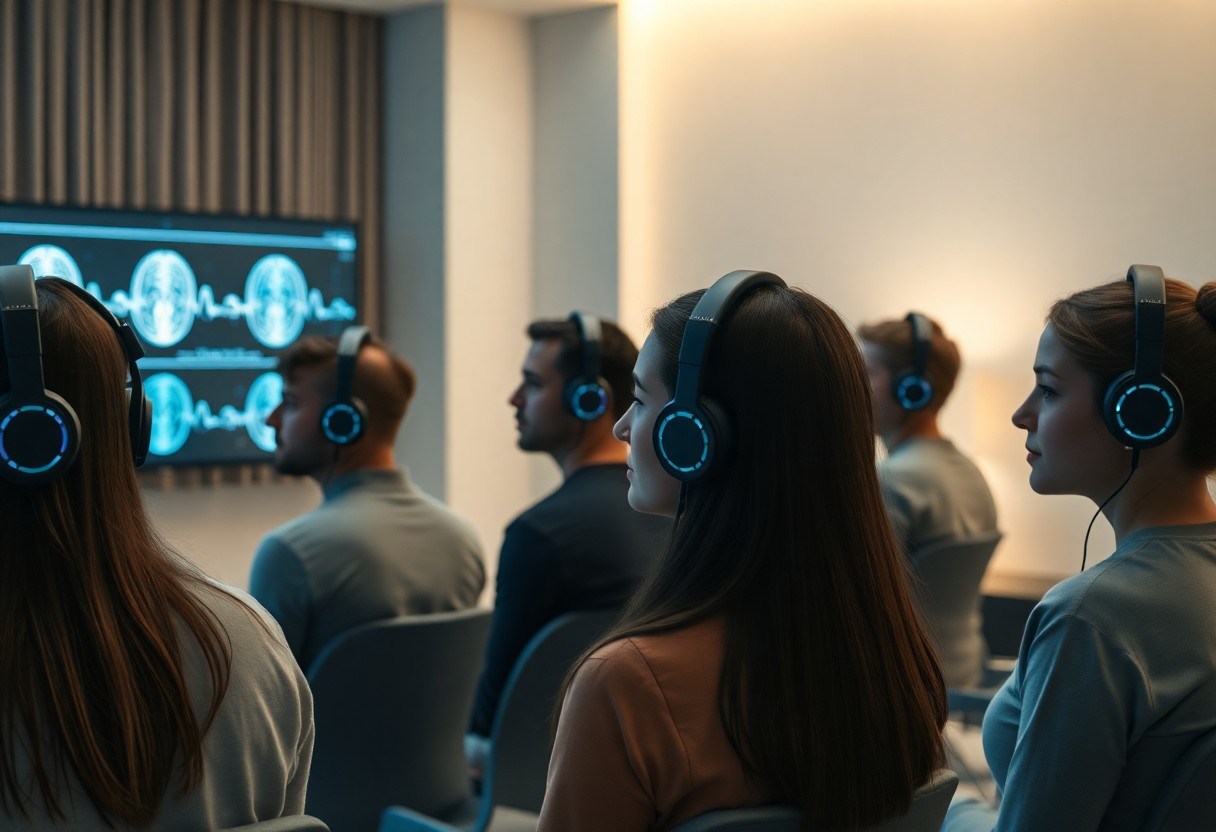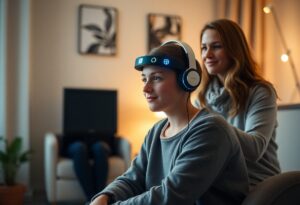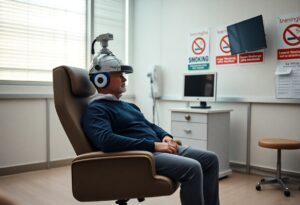Anxiety can often feel overwhelming, but with the emerging field of neurofeedback, you have a powerful tool at your disposal. This innovative brain training technique empowers you to regulate your own mental processes, potentially leading to reduced stress and worry. By monitoring your brain activity and providing real-time feedback, neurofeedback helps you develop greater emotional control and resilience. In this post, we’ll explore how this technology works and how it can transform your approach to managing anxiety.

Key Takeaways:
- Neurofeedback uses real-time data from brain activity to help individuals train their brain to operate in more beneficial patterns, particularly for reducing anxiety and stress levels.
- Brain training techniques promote relaxation by reinforcing positive brainwave activity, which can lead to substantial reductions in worry and anxiety symptoms.
Neurofeedback into therapy offers a holistic approach that empowers individuals to actively engage in their mental health journey, fostering greater emotional resilience.
Understanding Anxiety
Your mental health plays a significant role in your overall well-being, and understanding anxiety is a key part of maintaining that health. Anxiety is more than just feeling stressed or worried; it can impact various aspects of your life. Research suggests that neurofeedback can be effective in alleviating anxiety symptoms, as indicated by the Efficacy Evaluation of Neurofeedback-Based Anxiety Relief. This chapter will explore the definition, types, and symptoms of anxiety, providing insights into how it affects you.
Definition of Anxiety
Above all, anxiety is an emotional response characterized by feelings of tension, worried thoughts, and physical changes like increased blood pressure. This mental state can manifest in various ways and can lead to a heightened sense of fear or apprehension about future events.
Types of Anxiety Disorders
About 40 million adults in the United States experience some form of anxiety disorder. These disorders can lead to severe emotional and physical distress. The primary types include:
- Generalized Anxiety Disorder (GAD)
- Panic Disorder
- Social Anxiety Disorder
- Obsessive-Compulsive Disorder (OCD)
- Post-Traumatic Stress Disorder (PTSD)
The recognition of these types will help you understand your own experiences better.
| Type of Disorder | Description |
| Generalized Anxiety Disorder | Persistent and excessive worry about various aspects of life. |
| Panic Disorder | Recurring panic attacks with overwhelming fear and physical symptoms. |
| Social Anxiety Disorder | Intense fear of social interactions or being judged. |
| Obsessive-Compulsive Disorder | Intrusive thoughts and compulsive behaviors to alleviate anxiety. |
| Post-Traumatic Stress Disorder | Trauma-induced anxiety that affects daily functioning. |
Also, each type of anxiety disorder comes with its unique challenges and requires tailored approaches for effective management. You might find that understanding these variations can provide insights into your feelings and reactions. Different types of anxiety disorders may manifest through separate situations and symptoms, including:
- Physical symptoms like heart palpitations
- Emotional symptoms such as irritability
- Cognitive disruptions like difficulty concentrating
- Behavioral changes, such as avoidance of certain situations
- Impact on daily activities and relationships
The awareness of these symptoms can help you discuss your concerns more effectively with your healthcare provider.
Common Symptoms and Effects
Anxiety can manifest in various ways, making it important for you to recognize its symptoms. Common signs include restlessness, fatigue, irritability, and difficulties with sleep or concentration.
In addition to the cognitive and emotional disruptions you might face, anxiety can also have a profound impact on your physical health. Many individuals experience increased heart rate, muscle tension, or gastrointestinal issues. These physical symptoms can become intertwined with cognitive aspects of anxiety, making it hard to distinguish where one begins and the other ends. Understanding these effects can empower you to take control of your mental health.
The Brain and Anxiety
Any discussion about anxiety must begin with a look at the brain’s structure and function. Anxiety disorders are closely linked to specific areas of your brain, particularly the amygdala, prefrontal cortex, and hippocampus. The amygdala is responsible for processing emotions and fear, while the prefrontal cortex helps regulate your responses and decision-making. Understanding the neuroanatomy of anxiety can help you recognize how these brain regions interact and contribute to your feelings of stress and worry.
Neuroanatomy of Anxiety
With insights into the neuroanatomy of anxiety, you can better grasp how these brain regions work together to create anxious feelings. When the amygdala perceives a threat, it activates a fight-or-flight response. If the prefrontal cortex is unable to regulate this response effectively, it can lead to overwhelming fear and anxiety. The hippocampus, which is involved in memory processing, can also contribute by recalling past stressful experiences and triggering similar reactions in your present.
Neurotransmitters Involved
Neurotransmitters play a vital role in your emotional and mental health, particularly in the context of anxiety. These chemical messengers facilitate communication between neurons and are crucial for regulating mood. Serotonin, dopamine, and gamma-aminobutyric acid (GABA) are some key neurotransmitters that influence anxiety levels in your brain.
In addition to serotonin, dopamine, and GABA, other neurotransmitters such as norepinephrine and glutamate also affect your anxiety levels. Serotonin helps promote feelings of well-being, while GABA acts as an inhibitory neurotransmitter, calming excessive brain activity. Norepinephrine is involved in your body’s stress response, and glutamate can increase anxiety when levels are imbalanced. Understanding these neurotransmitters allows you to appreciate the chemical interplay that influences your anxiety.
The Role of Electrical Activity in Anxiety
Activity within the brain is another significant factor contributing to anxiety. Neurons communicate through electrical signals, and fluctuations in brain wave patterns can indicate heightened anxiety. When you experience anxiety, certain brainwaves, particularly beta waves, may become more pronounced, while alpha waves may diminish, leading to a state of overactivity.
Anxiety manifests itself through electrical activity as changes in your brain wave patterns. When you are calm, your brain produces alpha waves, promoting relaxation. However, when anxiety sets in, there is a shift towards faster beta wave activity, which can create racing thoughts and heightened stress responses. By understanding these electrical changes, you can recognize the impact that brain training techniques, such as neurofeedback, can have to help regulate your anxiety effectively.
Brain training through neurofeedback offers a fascinating approach to managing anxiety by helping you gain greater control over your mental state. This innovative method allows you to retrain your brainwaves, leading to reduced stress and worry in your daily life. By understanding how neurofeedback works and its benefits, you can explore a path toward improved emotional regulation and overall well-being. Let’s examine into the science behind neurofeedback and how it can empower you to alleviate anxiety naturally.
Neurofeedback and Anxiety Treatment
Unlike traditional treatment methods that may rely solely on medication or talk therapy, neurofeedback offers a unique approach to reducing anxiety by training your brain to function more effectively. This therapeutic modality involves real-time monitoring and feedback of brain activity, helping you develop self-regulation skills. For more insights, you can explore How Can Neurofeedback ‘Train the Brain’ to Be More Resilient.
Research Studies on Neurofeedback for Anxiety
Research has shown that neurofeedback can significantly reduce anxiety symptoms by promoting healthier brainwave patterns. Multiple studies suggest that participants undergoing neurofeedback training report fewer panic attacks and a marked decrease in stress levels post-treatment, highlighting its potential effectiveness as an anxiety management strategy.
Protocols and Techniques Used in Neurofeedback
Protocols in neurofeedback vary depending on individual needs and specific anxiety disorders. The approach typically involves placing sensors on your scalp to monitor brain activity. You then engage in specific mental tasks designed to train your brain to produce desired brainwaves associated with relaxation and focus.
Considering the varying protocols used in neurofeedback, practitioners often tailor sessions to your specific anxiety profile. Techniques may include creating visual or auditory feedback based on your brainwave activity, allowing you to understand and adjust your mental state during each session. The goal is to foster emotional regulation while minimizing anxiety symptoms.
Comparison with Traditional Treatment Methods
With several approaches available for treating anxiety, understanding the differences between neurofeedback and traditional treatment modalities can be beneficial. The following table outlines some key aspects:
Comparison of Neurofeedback and Traditional Treatments
| Neurofeedback | Traditional Treatments |
|---|---|
| Non-invasive brain training | Medication and therapy |
| Focuses on self-regulation | Often relies on prescribed medications |
| Personalized protocols | Standardized treatment methods |
| Long-term coping strategies | Temporary symptom relief |
Methods used in neurofeedback emphasize developing your brain’s ability to manage and reduce anxiety over time. This self-directed approach contrasts with traditional treatments, which may focus on managing symptoms without necessarily addressing the underlying neurophysiological patterns of anxiety. This difference in focus allows for sustainable change in how you respond to stressors.
The Neurofeedback Process
Initial Assessment and Goal Setting
Keep in mind that your neurofeedback journey begins with an initial assessment. After a thorough evaluation of your unique situation, you and your therapist will collaboratively establish specific goals tailored to your anxiety relief. This step is important, as it helps you gain clarity and direction in your neurofeedback training experience.
Session Structure and Frequency
Any effective neurofeedback training consists of structured sessions aimed at optimizing your brain’s function. To maximize the benefits, you will typically participate in sessions once or twice a week, lasting around 30 to 60 minutes each. This frequency allows your brain to gradually adapt and reinforce new, healthier patterns of activity beneficial for managing anxiety.
Monitoring Progress and Outcomes
Along your neurofeedback journey, ongoing monitoring is vital to gauge your progress. Your therapist will consistently assess your brainwave patterns, ensuring they align with your established goals. This systematic review will help you understand how your training affects your anxiety levels and emotional resilience.
Structure is key in the monitoring process, as you will receive feedback through various metrics and tools after each session. This information will empower you to stay engaged and motivated while allowing your therapist to make any necessary adjustments to your training plan. By keeping track of your improvements, you can see the positive impact of neurofeedback on your anxiety management.

Benefits and Limitations of Neurofeedback
After exploring the potential of neurofeedback for alleviating anxiety, it’s crucial to discuss both the benefits and limitations of this therapy. You can find more information about How Neurofeedback Can Help Anxiety through various resources.
Advantages of Neurofeedback for Anxiety
Any form of brain training aims to improve your mental well-being, and neurofeedback is no exception. By using real-time data from your brain activity, it teaches you to regulate your brainwaves. This can lead to reduced anxiety symptoms, better emotional regulation, and overall enhanced mental clarity, allowing you to navigate life’s challenges more effectively.
Potential Side Effects and Limitations
Anxiety about neurofeedback is natural, especially considering that not everyone responds the same way to treatments. Some individuals may experience mild side effects, such as headaches or temporary emotional shifts, while others might find the sessions to be productive and enlightening. It’s important to assess your personal experience during the process.
Limitations of neurofeedback can arise due to the variability in individual responses. While many people benefit from this therapy, others may see minimal improvement. Furthermore, the need for multiple sessions adds time and cost factors, which might not fit into everyone’s schedule or budget. Additionally, neurofeedback may not be a standalone solution for anxiety and is often best used in conjunction with other therapies.
Who Can Benefit from Neurofeedback?
Limitations may exist in terms of who finds neurofeedback useful. This form of therapy can be particularly beneficial for individuals who struggle with anxiety, chronic stress, or attention issues. However, those with more severe psychological disorders may require more traditional therapeutic approaches combined with neurofeedback for optimal results.
At its core, neurofeedback can serve a range of individuals seeking to improve their mental health. If you’re dealing with anxiety, focusing on self-regulation and brainwave optimization may lead you to discover a more empowering way to manage your symptoms. Assessing your unique needs can help determine if this approach is suitable for you, either alone or as a complement to your current treatment plan.
Conclusion
On the whole, engaging in neurofeedback for anxiety can significantly improve your ability to manage stress and worry. By training your brain to self-regulate, you enhance your emotional resilience and foster a greater sense of calm. This non-invasive approach empowers you to take control of your mental well-being, helping you navigate life’s challenges with confidence. Embracing neurofeedback might be the key to unlocking a more peaceful and balanced version of yourself.
Q: What is neurofeedback and how does it help with anxiety?
A: Neurofeedback is a type of biofeedback that trains individuals to regulate their brain activity. It utilizes real-time monitoring of brain waves using EEG technology. By providing feedback through visual or auditory signals, individuals learn to identify and modify their brain wave patterns associated with anxiety. Over time, this training can lead to decreased levels of stress and worry.
Q: What happens during a neurofeedback session aimed at reducing anxiety?
A: During a neurofeedback session, you’ll be fitted with sensors that measure your brain’s electrical activity. The therapist will guide you through specific exercises or tasks designed to help you alter your brain wave patterns. For instance, you may play a video game controlled by your brain activity where success is indicated by achieving a calm state. Each session typically lasts about 30 to 60 minutes, and participants often gain insight into their mental state during the process.
Q: How many sessions of neurofeedback are typically needed to see results for anxiety?
A: The number of sessions required can vary based on individual needs and the severity of anxiety symptoms. Generally, clients may start to notice improvements after 10 to 20 sessions, though some may require more. A tailored treatment plan will be developed based on an initial assessment and ongoing progress, ensuring the approach is effective for each individual’s unique situation.
Q: Is neurofeedback safe, and are there any side effects?
A: Neurofeedback is considered a safe and non-invasive therapy with minimal side effects. Most individuals experience no adverse effects, although some may feel slight fatigue or temporary emotional responses after a session. It’s imperative to work with a qualified practitioner who can provide guidance and support throughout the process, ensuring that any potential concerns are addressed.
Q: Can neurofeedback be used alongside other treatments for anxiety?
A: Yes, neurofeedback can be effectively combined with other therapeutic approaches, such as cognitive-behavioral therapy (CBT), medication, or mindfulness practices. This integrative approach often enhances overall treatment efficacy, as neurofeedback can help to reinforce the skills learned in other therapies while also providing clients with greater control over their anxiety symptoms.







